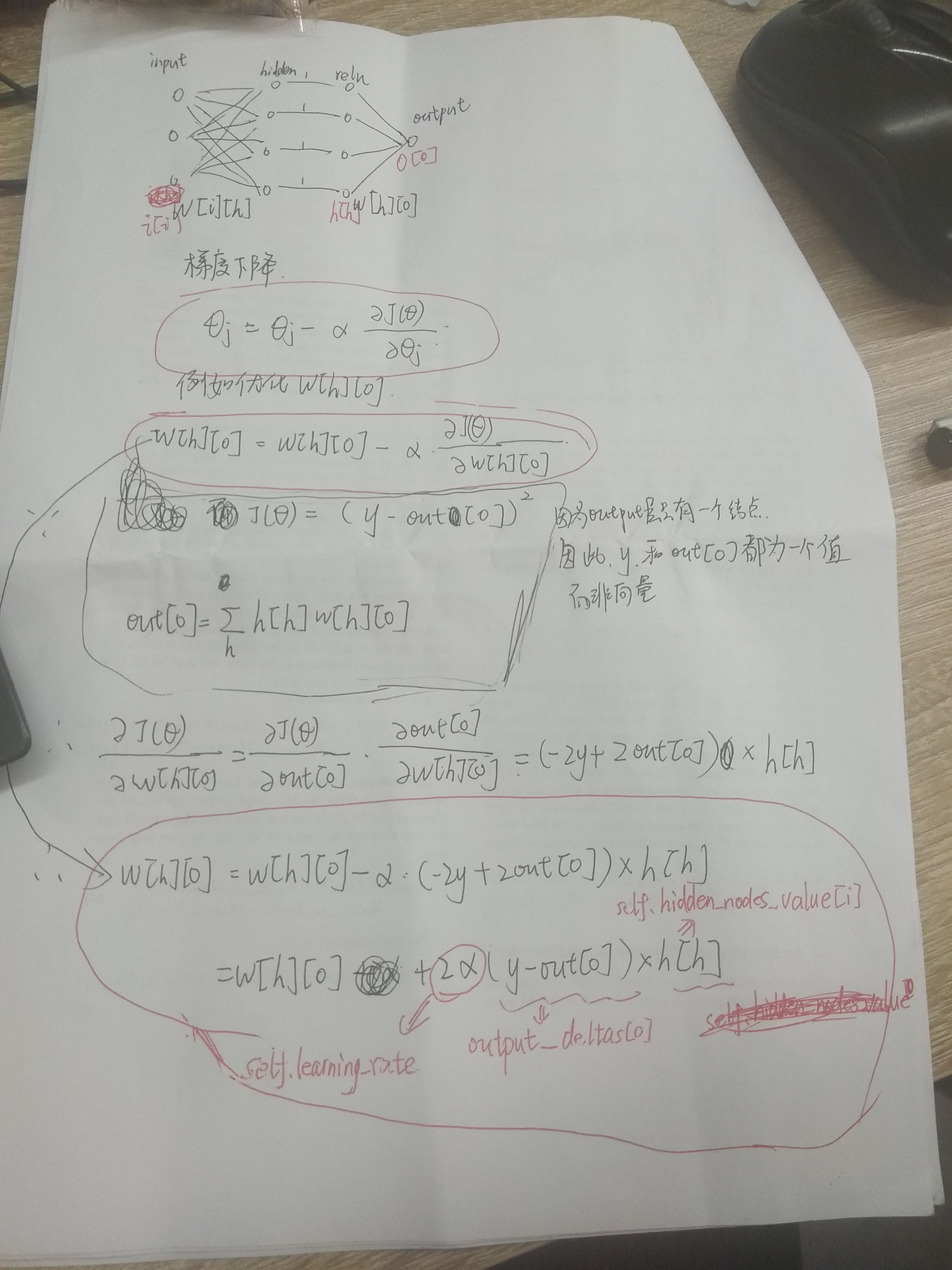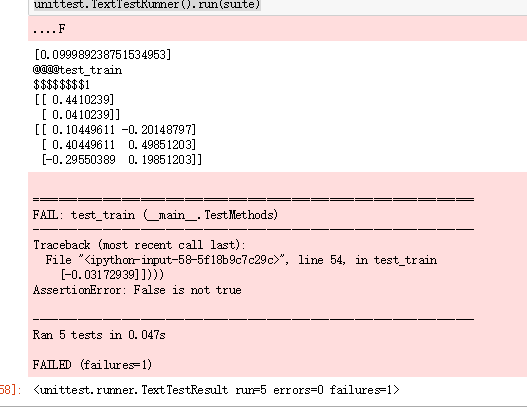贪玩ML系列之一个BP玩一天
手写串行BP算法,可调batch_size
既要:1、输入层f(x)=x 隐藏层sigmoid 输出层f(x)=x
2、run函数实现单条数据的一次前馈
3、train函数读入所有数据for循环处理每条数据。
循环中:
首先调用run函数,得到各层的值
self.input_nodes_value
self.hidden_nodes_value
self.output_nodes_value
然后计算输出层误差和delta
4、关键函数:用于前馈的sigmoid和用于反馈的sigmoid的导数
self.activation_function = lambda x : 1/(1+np.exp(-x)) # sigmoid函数,用于正向传播
self.delta_activation_function = lambda x: x-x**2 # sigmoid一阶导,用于反向传播
5、反向传播
使用梯度下降方法
下面是推导隐藏层(实际上为relu层)到输出层的权重w[h][o]的梯度下降公式的过程,对应的几个变量在下面的代码中用红色标出
关于梯度下降公式推导:
https://blog.csdn.net/wfei101/article/details/80807749
https://www.jianshu.com/p/17191c57d7e9

batch_size=1 # 输入层没有激活函数f(x)=x,隐藏层激活函数sigmoid,输出层激活函数f(x)=x
class NeuralNetwork(object):
def __init__(self, input_nodes, hidden_nodes, output_nodes, learning_rate): # 各层节点个数
self.input_nodes = input_nodes
self.hidden_nodes = hidden_nodes
self.output_nodes = output_nodes # 创建三个一维数组存放三层节点的值
# print(str(self.input_nodes)+" "+str(self.hidden_nodes)+" "+str(self.output_nodes))
self.input_nodes_value=[0.0]*input_nodes
self.hidden_nodes_value=[0.0]*hidden_nodes
self.output_nodes_value=[0.0]*output_nodes # Initialize weights
self.weights_input_to_hidden = np.random.normal(0.0, self.input_nodes**-0.5, (self.input_nodes, self.hidden_nodes))#输入层>>隐藏层权重矩阵 self.weights_hidden_to_output = np.random.normal(0.0, self.hidden_nodes**-0.5, (self.hidden_nodes, self.output_nodes))#隐藏层>>输出层权重矩阵 self.learning_rate = learning_rate#学习率 self.activation_function = lambda x : 1/(1+np.exp(-x)) # sigmoid函数,用于正向传播
self.delta_activation_function = lambda x: x-x**2 # sigmoid一阶导,用于反向传播 self.change_to_fix_weights_h2o=[[0.0]*self.output_nodes]*self.hidden_nodes#存储隐藏层>>输出层权重调整量
self.change_to_fix_weights_i2h=[[0.0]*self.hidden_nodes]*self.input_nodes#存储输入层>>隐藏层权重调整量
# print("xxxx")
# print(self.change_to_fix_weights_h2o)
# print(self.change_to_fix_weights_i2h) def train(self, features, targets):#完成n条数据的一次前向传递和反向传递,每个batch调整一次权重矩阵
'''
features: 2D array, each row is one data record, each column is a feature
targets: 1D array of target values '''
n=features.shape[0]#数据条数
# print(features)
# print(targets) counter=batch_size
for ii in range(0,n): self.run(features[ii])#调用前向传播 print(self.output_nodes_value) error_o=[0.0]*self.output_nodes#输出层误差
error_h=[0.0]*self.hidden_nodes#隐藏层误差
output_deltas=[0.0]*self.output_nodes
hidden_deltas=[0.0]*self.hidden_nodes for o in range(self.output_nodes): # 输 出 层
error_o[o]=targets[ii][o]-self.output_nodes_value[o]#计算输出层误差
# output_deltas[o]=self.delta_activation_function(self.output_nodes_value[o])*error_o[o]#输出层反向传播(求导)
output_deltas[o]=1*error_o[o]#输出层反向传播(求导) for h in range(self.hidden_nodes): # 隐 藏 层
for o in range(self.output_nodes):
# print('weight::',self.weights_hidden_to_output[h][o])
error_h[h]+=output_deltas[o]*self.weights_hidden_to_output[h][o]#计算隐藏层误差 # print('....')
# print(self.hidden_nodes_value[h])
# print(error_h[h])
hidden_deltas[h]=self.delta_activation_function(self.hidden_nodes_value[h])*error_h[h]#隐藏层反向传播
# print(hidden_deltas[h]) for h in range(self.hidden_nodes):
for o in range(self.output_nodes):
self.change_to_fix_weights_h2o[h][o]+=output_deltas[o]*self.hidden_nodes_value[h]#累计隐藏层>>输出层的权重矩阵的调整量 for i in range(self.input_nodes):
for h in range(self.hidden_nodes):
# print("......")
# print(hidden_deltas[h])
# print(self.input_nodes_value[i])
# print(self.change_to_fix_weights_i2h[i][h])
self.change_to_fix_weights_i2h[i][h]+=hidden_deltas[h]*self.input_nodes_value[i]#累计输入层>>隐藏层的权重矩阵的调整量 counter-=1
if counter==0:#完成一个batch的输入和计算后,调整一次权重
#调整隐藏层>>输出层权重
for h in range(self.hidden_nodes):
for o in range(self.output_nodes):
self.weights_hidden_to_output[h][o] += self.learning_rate*self.change_to_fix_weights_h2o[h][o] #调整输入层>>隐藏层权重
for i in range(self.input_nodes):
for h in range(self.hidden_nodes):
# print("......")
# print(self.weights_input_to_hidden[i][h])
# print(self.learning_rate)
# print(self.change_to_fix_weights_i2h[i][h])
self.weights_input_to_hidden[i][h] += self.learning_rate*self.change_to_fix_weights_i2h[i][h]
# print(self.weights_input_to_hidden[i][h])
#将权值调整量归零,计数器复位,开始输入下一个batch
self.change_to_fix_weights_h2o=[[0.0]*self.output_nodes]*self.hidden_nodes
self.change_to_fix_weights_i2h=[[0.0]*self.hidden_nodes]*self.input_nodes
counter=batch_size
return self.weights_hidden_to_output def run(self, features):#完成一条数据的一次前向传递
'''
features: 1D array of feature values
'''
# print(self.input_nodes_value)
for i in range(self.input_nodes):
self.input_nodes_value[i]=features[i]
# self.input_nodes_value[i]=self.activation_function(features[i])
# print(self.input_nodes_value) # print(self.hidden_nodes_value)
for h in range(self.hidden_nodes):
temp=0
for i in range(self.input_nodes):
temp+=self.input_nodes_value[i]*self.weights_input_to_hidden[i][h]
temp=self.activation_function(temp)
self.hidden_nodes_value[h]=temp
# print(self.hidden_nodes_value) # print(self.output_nodes_value)
for o in range(self.output_nodes):
temp=0
for h in range(self.hidden_nodes):
temp+=self.hidden_nodes_value[h]*self.weights_hidden_to_output[h][o]
# temp=self.activation_function(temp)
self.output_nodes_value[o]=temp
# print(self.output_nodes_value) return self.output_nodes_value
单元测试:
import unittest inputs = np.array([[0.5, -0.2, 0.1]])
targets = np.array([[0.4]])
test_w_i_h = np.array([[0.1, -0.2],
[0.4, 0.5],
[-0.3, 0.2]])
test_w_h_o = np.array([[0.3],
[-0.1]]) class TestMethods(unittest.TestCase): ##########
# Unit tests for data loading
########## def test_data_path(self):
# Test that file path to dataset has been unaltered
self.assertTrue(data_path.lower() == 'bike-sharing-dataset/hour.csv') def test_data_loaded(self):
# Test that data frame loaded
self.assertTrue(isinstance(rides, pd.DataFrame)) ##########
# Unit tests for network functionality
########## def test_activation(self):
network = NeuralNetwork(3, 2, 1, 0.5)
# Test that the activation function is a sigmoid
self.assertTrue(np.all(network.activation_function(0.5) == 1/(1+np.exp(-0.5)))) def test_train(self):
# Test that weights are updated correctly on training
network = NeuralNetwork(3, 2, 1, 0.5)
network.weights_input_to_hidden = test_w_i_h.copy()
network.weights_hidden_to_output = test_w_h_o.copy() network.train(inputs, targets)
print('@@@@test_train')
print("$$$$$$$$1")
print(network.weights_hidden_to_output)
print(network.weights_input_to_hidden) # network.train(inputs,targets) # print("$$$$$$$$2")
# print(network.weights_hidden_to_output)
# print(network.weights_input_to_hidden) self.assertTrue(np.allclose(network.weights_hidden_to_output,
np.array([[ 0.37275328],
[-0.03172939]])))
self.assertTrue(np.allclose(network.weights_input_to_hidden,
np.array([[ 0.10562014, -0.20185996],
[0.39775194, 0.50074398],
[-0.29887597, 0.19962801]]))) def test_run(self):
# Test correctness of run method
network = NeuralNetwork(3, 2, 1, 0.5)
network.weights_input_to_hidden = test_w_i_h.copy()
network.weights_hidden_to_output = test_w_h_o.copy() self.assertTrue(np.allclose(network.run(inputs[0]), 0.09998924)) suite = unittest.TestLoader().loadTestsFromModule(TestMethods())
unittest.TextTestRunner().run(suite)
结果:


结果虽然比较接近,但是代码比较丑陋,并没有用numpy的矩阵相乘,而是用for循环实现了矩阵乘法,代码复杂,而且都是串行的。
贪玩ML系列之一个BP玩一天的更多相关文章
- 贪玩ML系列之CIFAR-10调参
调参方法:网格调参 tf.layers.conv2d()中的padding参数 取值“same”,表示当filter移出边界时,给空位补0继续计算.该方法能够更多的保留图像边缘信息.当图片较小(如CI ...
- 每日一译系列-模块化css怎么玩(译文)
原文链接:How Css Modules Work 原文作者是Preact的作者 这是一篇关于如何使用Css Modules的快速介绍,使用到的工具是Webpack吊炸的css-loader 首先,我 ...
- ROS与Matlab系列:一个简单的运动控制
ROS与Matlab系列:一个简单的运动控制 转自:http://blog.exbot.net/archives/2594 Matlab拥有强大的数据处理.可视化绘图能力以及众多成熟的算法函数,非常适 ...
- net core天马行空系列: 一个接口多个实现类,利用mixin技术通过自定义服务名,实现精准属性注入
系列目录 1.net core天马行空系列:原生DI+AOP实现spring boot注解式编程 2.net core天马行空系列: 泛型仓储和声明式事物实现最优雅的crud操作 哈哈哈哈,大家好,我 ...
- NET中小型企业项目开发框架系列(一个)
当时的前端,我们开发了基于Net一组结构sprint.NET+NHibernate+MVC+WCF+EasyUI等中小型企业级系统开发平台,如今把整个开发过程中的步步进展整理出来和大家分享,这个系列可 ...
- Office365开发系列——开发一个全功能的Word Add-In
2016年10月我参加了在北京举行的DevDays Asia 2016 - Office 365应用开发”48小时黑客马拉松“,我开发的一个Word Add-In Demo——WordTemplate ...
- http协议学习系列(一个博文链接)
深入理解HTTP协议(转) http协议学习系列(转自:http://www.blogjava.net/zjusuyong/articles/304788.html) 1. 基础概念篇 1.1 介绍 ...
- 造轮子系列(三): 一个简单快速的html虚拟语法树(AST)解析器
前言 虚拟语法树(Abstract Syntax Tree, AST)是解释器/编译器进行语法分析的基础, 也是众多前端编译工具的基础工具, 比如webpack, postcss, less等. 对于 ...
- 爱上MVC3系列~开发一个站点地图(俗称面包屑)
回到目录 原来早在webform控件时代就有了SiteMap这个东西,而进行MVC时代后,我们也希望有这样一个东西,它为我们提供了不少方便,如很方便的实现页面导航的内容修改,页面导航的样式换肤等. 我 ...
随机推荐
- Atitit. Exception in thread "main" java.lang.Error: Unresolved compilation problem:
Atitit. Exception in thread "main" java.lang.Error: Unresolved compilation problem: 1.1. ...
- 通过exists判断数据,并查找存在的数据
----通过exists判断数据,并查找存在的数据---以scott用户的emp 及dept表为例 select * from emp; select * from dept; ---查找emp表中的 ...
- 在Linux下搭建git服务器
http://www.cnblogs.com/dee0912/p/5815267.html 步骤很详细,很受用
- 怎么来爬取代理服务器ip地址?
一年前突然有个灵感,想搞个强大的网盘搜索引擎,但由于大学本科学习软件工程偏嵌入式方向,web方面的能力有点弱,不会jsp,不懂html,好久没有玩过sql,但就是趁着年轻人的这股不妥协的劲儿,硬是把以 ...
- React系列——react-redux之connect方法解析
connect简介 前方高能预警,有耐心才能看完文章!! react-redux仅有2个API,Provider和connect,Provider提供的是一个顶层容器的作用,实现store的上下文 ...
- dd & cpio
dd: ------------------------------------------------------ - 指定大小块的拷贝一个文件 例1. 想把软盘的内容拷贝到另一个软盘 dd i ...
- 使用Selectivizr让你的 CSS3选择器 通吃IE6/7/8
说到HTML5,总是会让人不自觉的想到CSS3,貌似他们就应该是成双成对.OK!前几天和大家分享了<使用html5shiv让HTML5通吃IE6/7/8>,那今天,便再和大家分享一个能让H ...
- CI 点击图片刷新验证码
<img src="<?php echo site_url('home/login/code'); ?>" onclick= this.src="< ...
- 第二百一十五节,jQuery EasyUI,DateBox(日期输入框)组件
jQuery EasyUI,DateBox(日期输入框)组件 学习要点: 1.加载方式 2.属性列表 3.事件列表 4.方法列表 本节课重点了解 EasyUI 中 DateBox(日期输入框)组件的使 ...
- bash脚本IFS=',' read的意思
IFS is the Input Field Separator, which means the string read will be split based on the characters ...
